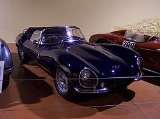
Jaguar XKSS
Encyclopedia
The Jaguar XKSS was a road-going version of the Jaguar D-Type
racing car.
After Jaguar withdrew from racing the company offered the remaining, unfinished chassis as the roadgoing Jaguar XKSS, by making changes to the racers: adding an extra seat, another door, a full-width windshield and folding top, as concessions to practicality. However, on the evening of 12 February 1957, a fire broke out at the Browns Lane plant destroying nine of the twenty-five cars that had already been completed or were semi-completed. Production is thought to have included 53 customer D-types, 18 factory team cars, and 16 XKSS versions.
Following Jaguar's withdrawal from competition at the end of the 1955 season, a number of completed and partially complete D-types remained unsold at the Browns Lane factory. In an attempt to recoup some of the investment made in building these unused chassis, and to exploit the lucrative American market for high-performance European sports cars, Sir William Lyons
decided to convert a number to full road-going specification. Only minor changes were made to the basic D-type structure: the addition of a passenger side door, the removal of the large fin behind the driver's seat, and the removal of the divider between passenger and driver seats. In addition, changes were made for cosmetic, comfort and legal reasons: a full-width, chrome-surrounded windscreen was added; sidescreens were added to both driver and passenger doors; a rudimentary, folding, fabric roof was added for weather protection; chromed bumpers were added front and rear (a styling cue later used on the E-type
); XK140
rear light clusters mounted higher on the wings; and thin chrome strips added to the edge of the front light fairings. In total 16 XKSS variants were made, with most being sold in the USA, before the Browns Lane fire destroyed the remaining chassis.
The American actor Steve McQueen
owned a Jaguar XKSS for personal use, painted British racing green
. He referred to the car as "the green rat". In 2010 and 2011 it toured the United States as part of the "Allure of the Automobile" exhibit.
Jaguar D-type
The Jaguar D-Type, like its predecessor the C-Type, was a factory-built race car. Although it shared the basic straight-6 XK engine design with the C-Type, the majority of the car was radically different...
racing car.
After Jaguar withdrew from racing the company offered the remaining, unfinished chassis as the roadgoing Jaguar XKSS, by making changes to the racers: adding an extra seat, another door, a full-width windshield and folding top, as concessions to practicality. However, on the evening of 12 February 1957, a fire broke out at the Browns Lane plant destroying nine of the twenty-five cars that had already been completed or were semi-completed. Production is thought to have included 53 customer D-types, 18 factory team cars, and 16 XKSS versions.
Following Jaguar's withdrawal from competition at the end of the 1955 season, a number of completed and partially complete D-types remained unsold at the Browns Lane factory. In an attempt to recoup some of the investment made in building these unused chassis, and to exploit the lucrative American market for high-performance European sports cars, Sir William Lyons
William Lyons
Sir William Lyons , known as "Mr. Jaguar", was with fellow motorcycle enthusiast William Walmsley, the co-founder in 1922 of the Swallow Sidecar Company, which became Jaguar Cars Limited after the Second World War....
decided to convert a number to full road-going specification. Only minor changes were made to the basic D-type structure: the addition of a passenger side door, the removal of the large fin behind the driver's seat, and the removal of the divider between passenger and driver seats. In addition, changes were made for cosmetic, comfort and legal reasons: a full-width, chrome-surrounded windscreen was added; sidescreens were added to both driver and passenger doors; a rudimentary, folding, fabric roof was added for weather protection; chromed bumpers were added front and rear (a styling cue later used on the E-type
Jaguar E-type
The Jaguar E-Type or XK-E is a British automobile, manufactured by Jaguar between 1961 and 1975. Its combination of good looks, high performance, and competitive pricing established the marque as an icon of 1960s motoring...
); XK140
Jaguar XK140
The Jaguar XK140 is a sports car manufactured by Jaguar between 1954 and 1957, the successor to Jaguar's highly successful XK120. Upgrades included better brakes, rack and pinion steering, increased suspension travel and modern tube type shock absorbers instead of the older lever arm...
rear light clusters mounted higher on the wings; and thin chrome strips added to the edge of the front light fairings. In total 16 XKSS variants were made, with most being sold in the USA, before the Browns Lane fire destroyed the remaining chassis.
The American actor Steve McQueen
Steve McQueen
Terrence Steven "Steve" McQueen was an American movie actor. He was nicknamed "The King of Cool." His "anti-hero" persona, which he developed at the height of the Vietnam counterculture, made him one of the top box-office draws of the 1960s and 1970s. McQueen received an Academy Award nomination...
owned a Jaguar XKSS for personal use, painted British racing green
British racing green
British racing green or BRG, a colour similar to Brunswick green, hunter green, forest green or moss green , takes its name from the green international motor racing colour of Britain. Although there is still some debate as to an exact hue for BRG, currently the term is used to denote a spectrum of...
. He referred to the car as "the green rat". In 2010 and 2011 it toured the United States as part of the "Allure of the Automobile" exhibit.
External links
- Information of the Jaguar XKSS in conceptcarz.com
- Coventry Racers - Pages for each of the 16 XKSS cars, including photos and short histories for many.

